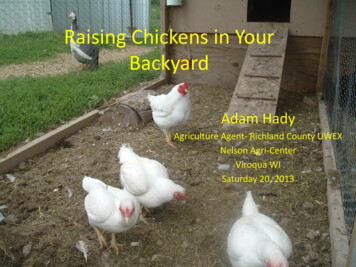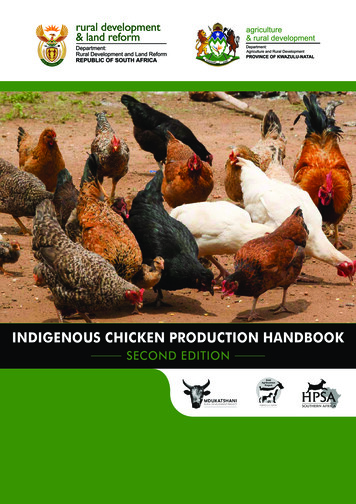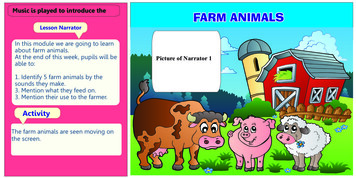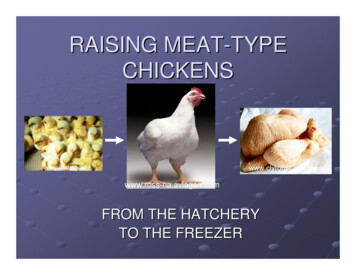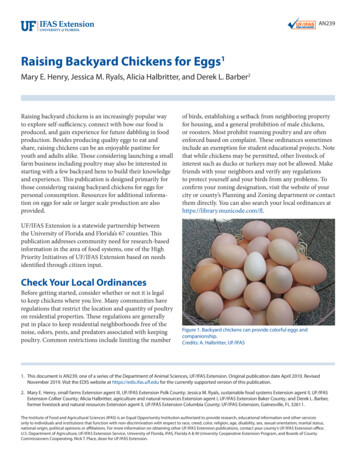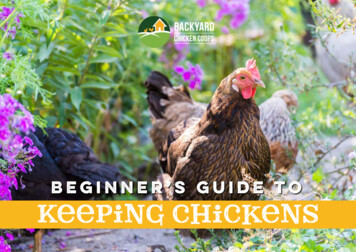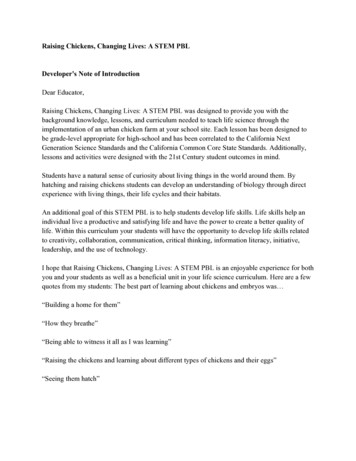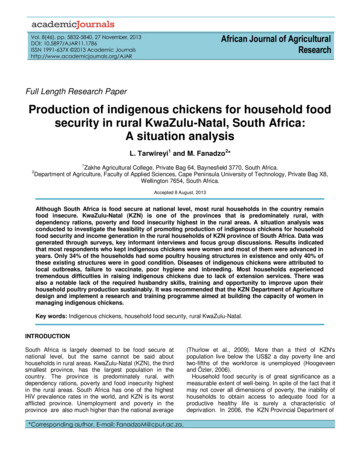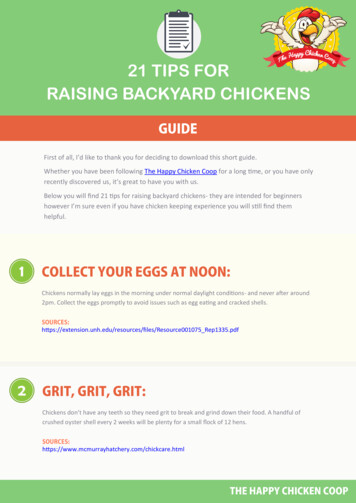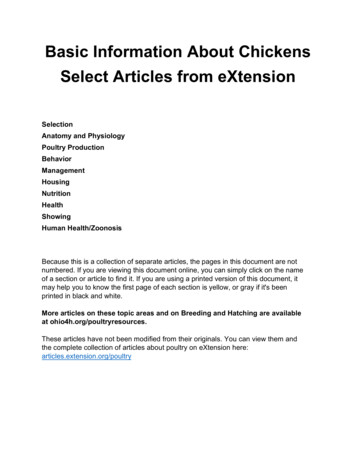
Transcription
Basic Information About ChickensSelect Articles from eXtensionSelectionAnatomy and PhysiologyPoultry ShowingHuman Health/ZoonosisBecause this is a collection of separate articles, the pages in this document are notnumbered. If you are viewing this document online, you can simply click on the nameof a section or article to find it. If you are using a printed version of this document, itmay help you to know the first page of each section is yellow, or gray if it's beenprinted in black and white.More articles on these topic areas and on Breeding and Hatching are availableat ohio4h.org/poultryresources.These articles have not been modified from their originals. You can view them andthe complete collection of articles about poultry on eXtension here:articles.extension.org/poultry
SelectionChicken Breed Selection (Schirtzinger, McDermott – ANR-60)
O H I OS T A T EU N I V E R S I T YE X T E N S I O Nextension.osu.eduagnr.osu.eduCHICK EN B REED SEL ECTIONANR-60Agriculture and Natural ResourcesDate: 08/17/2017Sabrina Schirtzinger , Extension Educator , Agriculture and Natural Resources, Knox CountyTim McDermott, Extension Educator , Agriculture and Natural Resources, Hocking CountyThere are various reasons people raise chickens: for eggs, meat, show and exhibition or simply to enjoy caringfor and watching chicks grow. For some, raising chickens is a hobby while others see it as a sustainable part ofliving. This fact sheet will explore characteristics of chicken breeds to help select the right breed for you.Wh at ar e y o u r g o al s f o r r ai s i n g c h i c k en s ?Before selecting the breed of chick to purchase, you need to ask yourself several questions. The first one is:What are your needs for your flock? This is important because you are looking at a commitment of potentiallyseven to eight years, which is the average lifespan of a chicken. Other questions include:What is your end goal for raising chickens?Do you want a certain type of egg, or are you looking for meat production chickens?Is your goal egg production, egg and meat production, or just meat production?Are you interested in raising chickens for show purposes and production is not important?Each breed of chicken has traits that make them better suited for exhibition, egg, meat or dual purposeproduction.Ter m i n o l o g yBeing able to talk “chicken” is important. Here are a few terms used for poultry:Hen: a female adult chickenRooster: a male adult chickenChick: a baby chicken of either sexPullet: a female chick (immature chicken)Cockerel: a male chick (immature chicken)Broody: a hen inclined or wishing to incubate eggsNon-Setting: a hen that does not have the inclination or wish to incubate eggsDual Purpose: chicken practical for meat and egg production
Eg g Pr o d u c t i o nAll hens will lay eggs; however, their egg production will vary. Arooster is not needed for egg production. Hens will lay nonfertile eggs without a rooster, a rooster is only needed if youwant fertile eggs in order to hatch chicks. A hen usually laysone egg every 26 hours; although, there may be days when ahen will not lay an egg at all. As the hen ages, the egg size willincrease; however, the shell quality and egg production willdecrease. Hens that are producing eggs will need extra calciumin their feed to support shell development. Egg colors varybetween breeds. Egg colors include: white, various shades ofbrown, or other colors such as blue and green. The best egglaying breeds tend to be the smaller bodied breeds such asAncona, Leghorn and Minorca.Figure 1. Ameraucana chicken is acommon backyard breed that laysblue/green eggs.The breed used the most for commercial egg laying is typicallyWhite Leghorns. These birds are intended to produce eggs at ahigher rate. Commercial producers only keep layers for twoyears before replacing the hen. White Leghorns are not usuallythe best choice for the novice backyard poultry enthusiast asthey can be loud, nervous and occasionally aggressive towardspeople.Eg g an d Meat Pr o d u c t i o nSome chicken breeds are referred to as dual-purpose breedsFigure 2. Chicken eggs vary in sizesthat will lay an adequate amount of eggs and grow largeand colors.enough for meat production. The downside, though, is that thechicken will not mature quickly like other breeds of meatchickens. Hybrid birds, also called sex-linked, tend to be good dual-purpose, but hybrid birds cannotreproduce.Meat Pr o d u c t i o nChickens that are bred solely for meat production are generally poor egg layers because these birds are fastergrowing. Because of their faster growth, meat birds require a larger amount of feed daily with a higher proteincontent compared to egg-laying birds. The fastest growing birds are a Cornish chicken crossed with a WhiteRock, which is referred to as a Cornish Cross. Using good livestock care practices, producers will have fryersat approximately seven weeks weighing 4 to 6 pounds, reaching roasting stage of 6 to 10 pounds in eight to 12weeks.Just like commercial egg layers, commercial meat birds have been selected for desired characteristics to beable to grow quickly with high feed efficiency. Similar to White Leghorns, the breeds used in commercialproduction are not usually the best choice for the backyard poultry enthusiast.Sh o w s an d Ex h i b i t i o n o f Po u l t r yShows offer an opportunity to display any breed of chicken and are becoming popular in the Midwest. TheAmerican Poultry Association (APA) has a publication called The American Standard of Perfection that has acomplete description of all the breeds and varieties of domestic chickens. This publication describes theappropriate breed characteristics needed for birds to be shown in exhibition.B u y i n g Yo u r Ch i c k en s
Day old chicks can be purchased from hatcheries or feedstores. Chicks that are sold as a “straight run” will be a mixtureof pullets (females) and cockerels (males). To buy only pullets,make sure the chicks are sexed. Before you purchase arooster, make sure the regulations in your area allow for them.Many cities have implemented rules on keeping backyardpoultry and do not allow roosters. A straight run purchase ofchicks should be avoided in this case and only pullets shouldbe purchased.Biosecurity refers to procedures implemented to protectanimals from disease-causing pathogens to help keep themhealthy. One of the biggest aspects of raising chickens, or anytype of livestock, is to make sure that biosecurity protocols arefollowed closely. Chickens should be purchased free of anydisease to avoid introducing a disease into your existing flock. Itis best to purchase similar age birds from a similar species atone time. Avoid purchasing poultry from unknown sources. DoFigure 3. Meat production chicken fornot bring a bird into your flock if you do not know its prior healthexhibition.record. The Animal Plant Health Inspection Service of the U.S.Department of Agriculture has a fact sheet to reference onbiosecurity. The fact sheet is available by searching for USDA poultry biosecurity.To help biosecurity, the National Poultry Improvement Plan (NPIP) was developed in the 1930s with themission to eradicate a number of major poultry diseases such as pullorum, salmonella, mycoplasma, and avianinfluenza. Breeders that are members are required to have their birds tested for pullorum-typhoid and bevaccinated against Marek’s disease. It is critical when purchasing chickens to only buy birds certified free ofNPIP diseases. Starting with healthy chicks is paramount to having a healthy flock. According to the OhioPoultry Association, the following Ohio hatcheries comply with NPIP regulations: Eagle Nest Poultry, MeyerHatchery, Mt. Healthy Hatchery, and Ridgway Hatchery.Wh at t em p er am en t o f c h i c k en i s i d eal f o r y o u an d y o u r f am i l y ?After you have decided the goal for your backyard flock (eggs, meat or show), another characteristic toconsider is breed temperament. Each breed has general temperament tendencies, but each bird will have aunique personality. If you are planning to have a small backyard flock of only three to five birds that areenjoyed as pets as well as producers in the local food chain for the family, you may consider a more docilebreed. If you plan to involve children as caretakers to learn about keeping and taking care of animals, choose abreed with characteristics that are more compatible with your family so the children will enjoy the experience.Breeds with the reputation for docility include: Plymouth Rock, Wyandotte and Orpington. These may be goodchoices for the novice backyard poultry enthusiast or if young children will be helping to raise and care for thepoultry. Roosters, of any breed, on the other hand are naturally aggressive and may not be suitable for thenovice poultry enthusiast or flocks where children are caring for the birds.Individual bird behavior is unpredictable. The breed characteristics should be used only as a guide knowingthat selecting primarily for temperament is difficult. Using a reputable and knowledgeable breeder is a goodstart in choosing which breed of chickens you wish to select to start your backyard flock.
Figure 4. Buff Brahmas are a gentle breed.Figure 5. Black Australorps are a popular brown egg breed.Ch i c k en B r eed sSelecting the best breed of chicken can be difficult as there are so many choices. Understanding theirdifferences will help to save you time and money. The following chart highlights characteristics considered byproducers when determining the breeds for their flocks. It is designed to be a starting point when decidingbetween all the breeds. Once you pick the breed you are most interested in, further research of the breed isencouraged.BreedVarietiesEgg ColorAmeraucanaBlack, Blue, Blue Wheaten,Brown Red, Buff, Silver,Wheaten, WhiteBlue/GreenAnconasSingle Comb and geMedium sizedchicken, colorfulfeather patterns.Excellent egg layers.EggsExtraLargeKnown for beingexcellent large egglayers. Non- setting.EggsDualAustralorpsBlackBrownLargePopular breed forlight brown eggs,heavy bird used formeat as well.BrahmasLight, Dark, BuffBrownLargeHeavy-bodied,broody breed.EggsDualBuckeyeOnly one varietyBrownLargeHeavier and widerbodied breed,excellent dualpurpose.ButtercupsGold, SilverWhiteMediumMainly used for eggproduction.EggsMediumSmaller-bodied breedmore suitable for egglaying.EggsCampinesSilver, GoldenWhite
BreedVarietiesEgg , Partridge. White,Black, Barred, SilverLaced, Golden Laced,Blue, BrownCornishDark, White, White Laced,Blue, BrownExcellent meatchickens.MeatOnly one varietyLargeMostly white withbarred tail and hackle(neck feathers).DualLargeAn American whiteand black barredbreed (also known ascuckoo pattern).Adapt well toclimates.ExhibitionMediumVersatitle breed usedfor meat and eggproduction. Has redear lobes, butproduces white eggs.DualDualDelawaresDominiquesDorkingsSingle CombOnly one varietySilver Gray, Colored,Cuckoo, Red, WhiteBrownBrownBrownWhiteSmallFluffy feather, broodybreed, andconsidered one of thelargest breeds.EggsFaverollesSalmon, WhiteLightBrownMediumDual Purpose breed,mainly used forexhibition and has 5toes.HamburgBlack, Golden Penciled,Golden Spangles, SilverPenciled, Silver Spangled,WhiteWhiteMediumExcellent large egglayers and goodforagers.EggsDualJerseyGiantsBlack, Blue, WhiteBrownLargeLarge, heavy breedused for eggproduction and meat.LeghornLight Brown, Dark brown,White, Buff, Black, Silver,Red, Black Tailed Red,ColumbianWhiteExtraLargeProlific egg layerEggsDualEggsMaranBlack Copper, WheatenDarkBrownExtraLargeExcellent egg layerswith very dark browneggs. May be usedfor meat.MinocraSingle comb black, Singlecomb white, Rose combblack, Single comb buff,Rose comb white,WhiteExtraLargeLarge framed, hardyand active breed.
BreedNewHampshireRedOrpingtonVarietiesRedBlack, Blue, Buff, WhiteEgg xtraLargeDual Purpose breed,used more for meatproduction.DualLargeHeavy dual purposebreed, and anexcellent egg layer.Known to lay well inthe winter monthstoo.DualDualPlymouthRockBarred, White, Buff,Partridge, Silver Penciled,Blue, ColumbianBrownLargeDual purpose broodychickens that willmake good mothers,and do not mind thecold.PolishBearded andNonBeardedGolden Silver, White, BuffLaced, White Crested Blue,Black, Crested WhiteWhiteMediumProlific egg layers,similar to Leghorns.EggsMediumThis breed is a goodegg layer, meatchicken and exhibtionbreed.DualDualRedCapsOnly one varietyWhiteRhodeIsland RedsSingle Comb and RoseCombBrownLargeKnown for being thebest egg layer as adual purpose breed.SussexSpeckled, Red, Light,Brown, Silver, BuffBrownLargeDual purpose breed.DualWelsummersOnly one varietyVery DarkBrownLargeGood egg productionchicken, cold weatherhardy with a dociletemperment.EggsWyandottesSilver Laced, GoldenLaced, White, Black, Buff,Partridge, Silver Penciled,Columbian, BlueLargeDual purpose breed.Cold weather hardyand make a goodexhibition bird.DualBrownSo u r c es :Akers, D., Akers, P., & Latour, M. A., (2002). Choosing a Chicken Breed: Eggs, Meat, or Exhibition.Animal Sciences Poultry, AS(518), w, 1-4. Retrieved April 20, 2016, ers, D., Akers, P., & Latour, M. A., (2002, October). Choosing a Chicken Breed: Eggs, Meat, orExhibition AS-512-W. Retrieved April 25, 2016, from extension.purdue.edu/extmedia/as/as-518.pdf.Breeds of Livestock. (1995, February 22). Information on breeds. Retrieved April 20, 2016, ens.html#h.Murray McMurray Hatchery. (n.d.). Information on breeds. Retrieved April 20, 2016, frommcmurrayhatchery.com/index.html.
National Poultry Improvement Plan: Poultryimprovement.org.Ohio Poultry Association: ohpoultry.org.The American Standard of Perfection. (2015, April). Presents the official breed descriptions for large fowl,bantams, waterfowl, and turkeys. Retrieved April 18, 2016, from amerpoultryassn.com/.All photos by Sabrina Schirtzinger, OSU Extension.Ohiolinehttps://ohioline.osu.eduOhio State University Extension embraces human diversity and is committed to ensuring that all research and related educational programsare available to clientele on a nondiscriminatory basis without regard to age, ancestry, color, disability, gender identity or expression, geneticinformation, HIV/AIDS status, military status, national origin, race, religion, sex, sexual orientation, or veteran status. This statement is inaccordance with United States Civil Rights Laws and the USDA.Roger Rennekamp, Associate Dean and Director, Ohio State University ExtensionFor Deaf and Hard of Hearing, contact Ohio State University Extension using your preferred communication (e-mail, relay services, or videorelay services). Phone 1-800-750-0750 between 8 a.m. and 5 p.m. EST Monday through Friday. Inform the operator to dial 614-292-6181.Copyright 2017, The Ohio State University
Anatomy and PhysiologyExternal Anatomy of Poultry Kept on Small or Backyard Flocks: ChickensCombWattlesAnatomy of a FeatherAvian Digestive SystemAvian Immune SystemAvian Muscular SystemAvian Reproductive System – FemaleAvian Reproductive System - MaleAvian Respiratory SystemAvian Skeletal System
eXtensionExternal Anatomy of Poultry Kept on Small or BackyardFlocks: ks:-chickenWritten by: Dr. Jacquie Jacob, University of KentuckyThe basic external parts of a chicken include the comb, beak, wattles, ears, earlobes, eyes, eye rings,wings, tail, thighs, hocks, shanks, spurs, claws, and toes. As Figure 1 shows, both male and femalechickens have these basic parts. The differences between males and females include the size of thecomb and wattles, the size of the spurs (in older birds), and the characteristics of the hackle and capefeathers. Hackle and cape feathers of males have pointed ends, whereas those of females haverounder ends. In addition, males have sickle feathers in their tails and hackle feathers on their backs,and females do not.
Fig. 1. Parts of an adult male chicken and an adult female chicken. Source: University of Illinois. Usedwith permission.A chicken's wing has several flight feathers. As Figure 2 shows, the axial feather separates the primaryfeathers and secondary feathers. When a hen molts, she starts losing feathers from the axial featherout.Fig. 2. Primary feathers (numbered 1through 10) and axial feather of an adultchicken. Source: Jacquie Jacob, University ofKentucky.The thigh of a chicken is the upper part ofthe leg attached to the body of the bird.The thigh ends at the lower leg (drumstick).The thigh is connected to the shank (foot)at the hock joint, which is the equivalent ofthe ankle in humans. Chickens stand andwalk on their toes. Most chickens havethree toes projecting forward and oneprojecting back, sometimes referred to asthe claw. A few breeds, however, have fivetoes on each foot. Some breeds also have feathers on their shanks and toes. Figure 3 compares thelegs of a female chicken and a male chicken, and Figure 4 compares the bones in a chicken leg withthose of a human leg.Fig. 3. Legs of a female chicken (left) and a male chicken (right). Source: Jacquie Jacob, University ofKentucky.Fig. 4. Comparison of the lower portion of the skeleton of a chicken (left) and the lower portion of theskeleton of a human (right). Source: Public domain images.
A chicken's head has several parts, as shown in Figure 5. One of themost prominent features on a chicken's head is the comb. Figure 6shows different types of combs. A chicken's comb and wattles arered, soft, and warm. Chickens do not have external ears as humans do.The ears are just openings into the ear canal, and each is protected bya covering of feathers. The ear lobe is a specialized skin located belowthe ear. The color of the ear lobe depends on the breed of chicken.The two possible colors are red and white. The eyeball is covered bythe eye ring. When the eye is open, the eye ring appears as a ring ofskin around the eye (thus the name eye ring).Fig. 5. Parts of a rooster's head. Source: Jacquie Jacob, University ofKentucky.
Fig. 6. Comb types. Source: University of Illinois. Used with permission.For More InformationPoultry: A Guide to Anatomy and Selected Species, University of Illinois
mbA comb is the fleshy, red outgrowth on top of a chicken's head. Types of combs,shown below, include single, rose, pea, cushion, strawberry, buttercup, and V-shaped. The combprimarily is for display, but it also serves to cool the bird in hot weather. In hens, the comb is anindicator of egg production status. A large, red comb typically indicates a hen that is laying eggs; asmall, pink comb indicates a bird that is not laying.Different types of chicken combs. Source:University of Illinois. Used with permission.
/wattlesWattles refers to the flap of skin under the chin of a chicken or turkey.Figure 1. Labeled parts of a chicken's head. Source:Jacquie Jacob, University of KentuckyFigure 2. Labeled parts of a turkey's head. Source:Jacquie Jacob, University of Kentucky
eXtensionAnatomy of a of-a-featherWritten by: Dr. Jacquie Jacob, University of KentuckyBirds come in different shapes and sizes, but one thing they have in common is feathers. Feathers areunique to birds; that is, everything that has feathers is a bird. Figure 1 shows feathers of various sizes,shapes, colors, and purposes on an adult male rooster.Fig. 1. Parts of an adult male rooster.Source: John Anderson, The Ohio StateUniversity.Feathers play three main roles in birds'lives:Feathers provide insulation, allowingbirds to maintain their bodytemperatures in a wide variety ofenvironmental conditions.Certain feathers are instrumental inallowing birds to fly.Because they come in differentshapes and colors, feathers provideindividual plumage that can serve to camouflage a bird or attract a mate.Figures 2 and 3 illustrate features of flight feathers, and Figure 4 shows a feather whose purpose isornamentation.Fig. 2. Parts of a feather. Source: JesseLyons, University of Missouri.Fig. 3. Electron microscope image of part ofa pheasant secondary flight feather. Flightfeathers must be tough to withstand therigors of flight. The barbs on a flight featherare strong and are connected to adjoiningbarbs of the same vane by the hooks onthe barbules. Source: John Anderson, TheOhio State University.Fig. 4. Electron microscope image of part ofa peacock eye feather. This feather isornamental and not meant to withstand theforces a flight feather must endure. Spacingexists between the barbs, and the hooks do not hold the barbs together. The ridges on the barbs arepart of the complex color-producing system present on peafowl. Source: The Ohio State University.
eXtensionAvian Digestive estive-systemWritten by: Dr. Jacquie Jacob, University of KentuckyAn understanding of the avian digestive system is essential for developing an effective andeconomical feeding program for your poultry flock and for recognizing when something is wrongand taking necessary actions to correct the problem.The digestive system of any animal is important in converting the food the animal eats into thenutrients its body needs for growth, maintenance, and production (such as egg production). Ananimal's body breaks down food through both mechanical and chemical means. In many animals,mechanical action involves chewing; however, because birds do not have teeth, their bodies useother mechanical action. Chemical action includes the release of digestive enzymes and fluids fromvarious parts of the digestive system. After being released from food during digestion, nutrients areabsorbed and distributed throughout the animal's body.Parts of a Chicken Digestive TractThe chicken has a typical avian digestive system. In chickens, the digestive tract (also referred to asthe gastrointestinal tract or GI tract) begins at the mouth, includes several important organs, andends at the cloaca. Figure 1 shows a chicken digestive tract, and Figure 2 shows the location of thedigestive tract in the chicken's body.Fig. 1. Digestive tract of a female chicken. Source: Jacquie Jacob, University of Kentucky.
Fig. 2. Location of the digestive tract in a female chicken. Source: Public domain.Beak/MouthAs with most birds, a chicken obtains feed by using its beak. Food picked up by the beak enters themouth. Chickens do not have teeth, so they cannot chew their food. However, the mouth containsglands that secrete saliva, which wets the feed to make it easier to swallow. Also, the saliva containsenzymes, such as amylase, that start the digestion process. The chicken uses its tongue to push thefeed to the back of the mouth to be swallowed.EsophagusThe esophagus is a flexible tube that connects the mouth with the rest of the digestive tract. It carriesfood from the mouth to the crop and from the crop to the proventriculus.CropThe crop is an out-pocketing of the esophagus and is located just outside the body cavity in the neckregion (see Figure 3). Swallowed feed and water are stored in the crop until they are passed to therest of the digestive tract. When the crop is empty or nearly empty, it sends hunger signals to thebrain so that the chicken will eat more.Fig. 3. Location of the crop in a female chicken. Source: Jacquie Jacob, University of KentuckyAlthough the digestive enzymes secreted in the mouth began the digestion process, very littledigestion takes place in the crop—it is simply a temporary storage pouch. The crop evolved for birdsthat are typically hunted by other animals but need to move to the open to find feed. These birds canconsume relatively large amounts of food quickly and then move to a more secure location to digestthat food.Occasionally, the crop becomes impacted, or backed up. This problem—called crop impaction, cropbinding, or pendulous crop—can occur when a chicken goes a long time without feed and then eatstoo much too quickly when feed is available again. Crop impaction also can occur when a chicken
free-ranges on a pasture of tough, fibrousvegetation or eats long pieces of string. Withcrop impaction, even if a chicken continuesto eat, the feed cannot pass the impactedcrop. The swollen crop also can block thewindpipe, causing the chicken to suffocate.ProventriculusThe esophagus continues past the crop, connecting the crop to the proventriculus. Theproventriculus (also known as the true stomach) is the glandular stomach where digestion primarilybegins. Hydrochloric acid and digestive enzymes, such as pepsin, are added to the feed here andbegin to break it down more significantly than the enzymes secreted by the salivary glands. At thispoint, however, the food has not yet been ground—this organ is called the proventriculus because itslocation in the digestive tract is before the ventriculus, where food is ground (see Figure 4).Fig. 4. Two views of the proventriculus and gizzardfrom a chicken digestive tract. Source: JacquieJacob, University of KentuckyVentriculus (Gizzard)The ventriculus, or gizzard, is a part of the digestive tract of birds, reptiles, earthworms, and fish.Often referred to as the mechanical stomach, the gizzard is made up of two sets of strong musclesthat act as the bird's teeth and has a thick lining that protects those muscles (see Figure 5).Consumed feed and the digestive juices from the salivary glands and proventriculus pass into thegizzard for grinding, mixing, and mashing.
Fig. 5. Inside of a chicken gizzard, with the internal lining removed. Source: Jacquie Jacob, Universityof KentuckyWhen allowed to free-range, chickens typically eat small stones. The acidic environment in theproventriculus softens the stones, and then the strong muscles of the gizzard grind them into tinypieces. The stones remain in the gizzard until they are ground into pieces small enough to pass to therest of the digestive tract.Grit, a commercial product made up of small stones, can be used as a supplement to chicken feed.Chickens fed only commercially prepared feed do not need grit. Chickens that eat whole grains orchickens kept on pasture that do not consume enough pebbles with the forage typically require asupplementation of grit. Grit should not be confused with limestone or oystershell, which are given tolaying hens as sources of calcium for their eggs' shells.When a chicken eats a small, sharp object, such as a tack or staple, the object is likely to get stuck inthe gizzard. Because of the strong grinding motion of the gizzard's muscles, such sharp objects canput holes in the gizzard wall. Chickens with damaged gizzards grow thin and eventually die.Preventing this situation is a good reason to keep a poultry house free of nails, glass shards, bits ofwire, and so on.Small IntestineThe small intestine is made up of the duodenum (also referred to as the duodenal loop) and thelower small intestine. The remainder of the digestion occurs in the duodenum, and the releasednutrients are absorbed mainly in the lower small intestine.The duodenum receives digestive enzymes and bicarbonate (to counter the hydrochloric acid fromthe proventriculus) from the pancreas and bile from the liver (via the gall bladder). The digestivejuices produced by the pancreas are involved primarily in protein digestion. Bile is a detergent that isimportant in the digestion of lipids and the absorption of fat-soluble vitamins (A, D, E, and K).The lower small intestine is composed of two parts, the jejunum and the ileum. The Meckel'sdiverticulum marks the end of the jejunum and the start of the ileum (see Figure 6). The Meckel'sdiverticulum is formed during a chicken's embryonic stage. In the egg, the yolk sac supplies thenutrients needed for the embryo to develop and grow. Right before hatch, the yolk sac is taken intothe navel cavity of the embryo. The residual tiny sac is the Meckel's diverticulum.
Fig. 6. Location of the Meckel's diverticulum in thedigestive tract of a chicken. Source: Jacquie Jacob,University of Kentucky.CecaThe ceca (plural form of cecum) are two blind pouches located where the small and large intestinesjoin. Some of the water remaining in the digested material is reabsorbed here. Another importantfunction of the ceca is the fermentation of any remaining coarse materials. During this fermentation,the ceca produce several fatty acids as well as the eight B vitamins (thiamine, riboflavin, niacin,pantothenic acid, pyridoxine, biotin, folic acid, and vitamin B12). Because the ceca are located soclose to the end of the digestive tract, however, few of the produced nutrients are absorbed andavailable to the chicken.Large Intestine (Colon)Despite the name, the large intestine is actually shorter than the small intestine. The large intestine iswhere the last of the water reabsorption occurs.CloacaIn the cloaca, the digestive wastes mix with wastes from the urinary system (urates). Chickens usuallyvoid fecal material as digestive waste with uric acid crystals on the outer surface—that is, chickens donot urinate. The color and texture of chicken fecal material can indicate the health status of thechicken's digestive tract: the white, pasty material coating chicken fecal material is uric acid, the avianform of urine, and is normal.The reproductive tract also exits through this area. When a hen lays an egg, the vagina folds over toallow the egg to leave through the cloaca opening without coming into contact with feces or urine.Intestinal MicrofloraBoth the small and large intestines normally are populated with beneficial or
There are various reasons people raise chickens: for eggs, meat, show and exhibition or simply to enjoy caring for and watching chicks grow. For some, raising chickens is a hobby while others see it as a sustainable part of living. This fact sheet will explore characteristics
